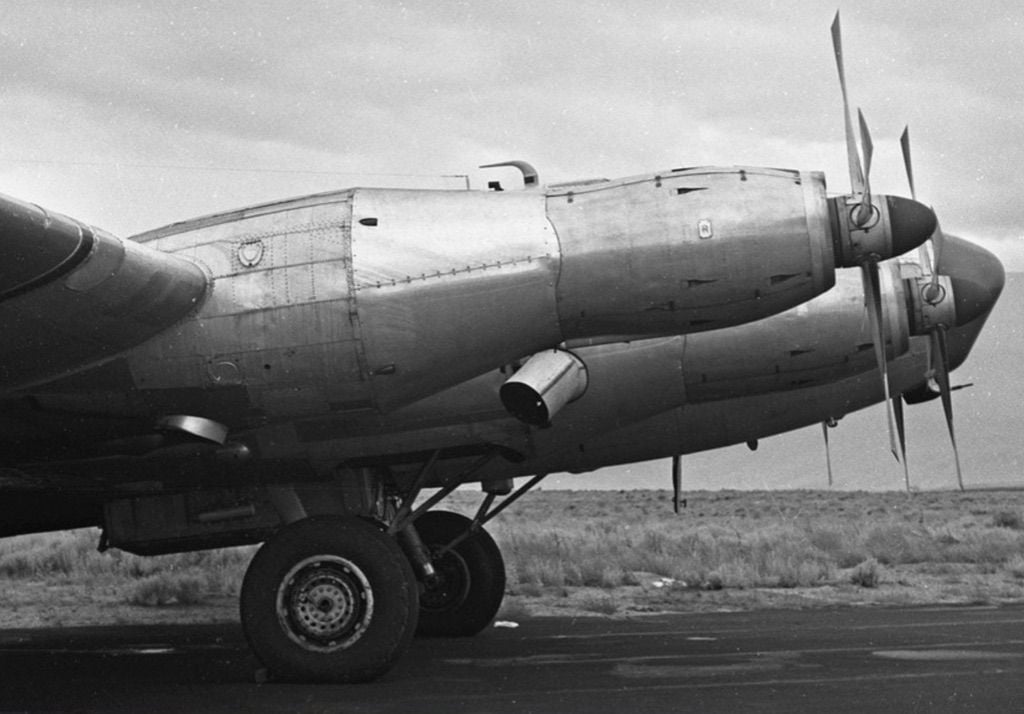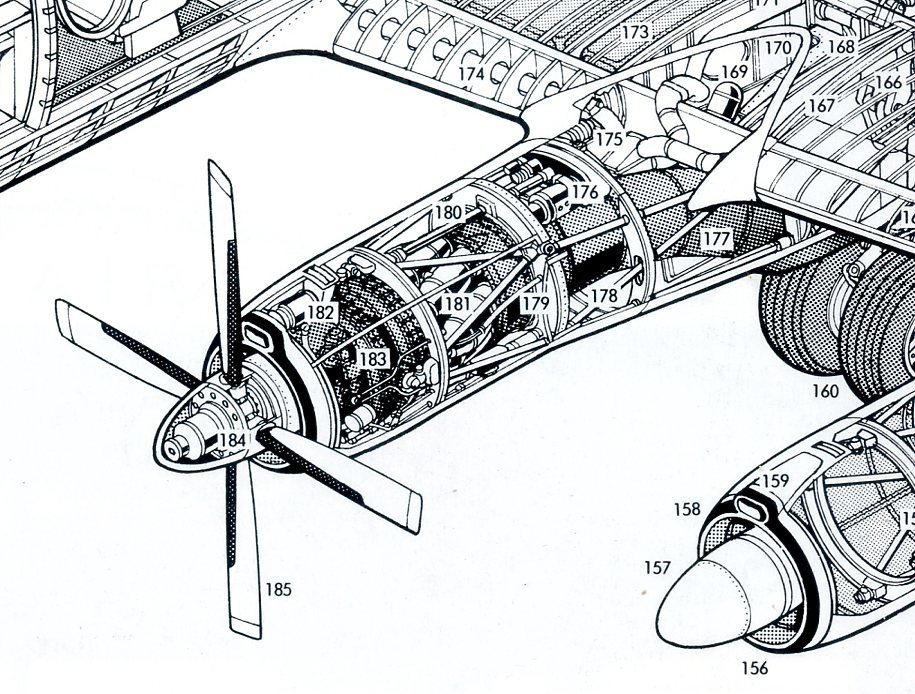Historical question: Vickers Viscount
Thread Starter
Join Date: Mar 2021
Location: Sydney
Posts: 5
Likes: 0
Received 0 Likes
on
0 Posts
Historical question: Vickers Viscount
I remember reading somewhere, more years ago than I care to remember, that the reason the Vickers Viscount had such long engine nacelles - longer than was strictly necessary to accommodate the Dart engines - was that the initial design called for four Alvis Leonides radial engines. At an advanced stage of prototype development, the Brabazon Committee decided that the Viscount should be the "go for broke" option, using all the latest technology - pressurisation and turboprop engines in particular - while the Airspeed Ambassador, a conservative design to the same specification using tried-and-true WW2 technology, would represent a fallback position. Rather than engage in a time-consuming redesign, the Vickers engineers simply lengthened the nacelles to preserve cg position.
Recently I've been searching the net for some confirmation of this account, but without success. Can anybody out there throw light on this?
Recently I've been searching the net for some confirmation of this account, but without success. Can anybody out there throw light on this?
I haven't heard of that but Wiki pages for the Viscount and Ambassador show a loose connection between the two.
Interestingly, the Handley Page Herald was originally designed with four Leonides in mind and the prototype flew in that configuration but subsequent aircraft were powered by two Darts.
Interestingly, the Handley Page Herald was originally designed with four Leonides in mind and the prototype flew in that configuration but subsequent aircraft were powered by two Darts.
Thread Starter
Join Date: Mar 2021
Location: Sydney
Posts: 5
Likes: 0
Received 0 Likes
on
0 Posts
Yes, I checked Wiki... it was a while ago, but I seem to remember that it was a bit thin on information concerning the early design and development stages. On further reflection, it occurs to me that I might have got the development story from my uncle, who worked for BEA for many years from the mid-1950s on. BEA operated both types of aircraft, of course, but I believe the Ambassador never really paid its way.
An Ambassador was fitted with turbo props but much later.
Even later, the Shorts Skyvan was originally designed for Lycomings but Astazous were fitted to the prototype.
Even later, the Shorts Skyvan was originally designed for Lycomings but Astazous were fitted to the prototype.
I remember reading somewhere, more years ago than I care to remember, that the reason the Vickers Viscount had such long engine nacelles - longer than was strictly necessary to accommodate the Dart engines - was that the initial design called for four Alvis Leonides radial engines.
Recently I've been searching the net for some confirmation of this account, but without success. Can anybody out there throw light on this?
Recently I've been searching the net for some confirmation of this account, but without success. Can anybody out there throw light on this?
The Brabazon Type 11B (the Viscount) was always destined for Turboprops with the Type 11A (the Ambassador) being piston-powered. That was all 1945-time. The first RR turboprop was actually a pair of modified Derwents on a Meteor, again in 1945, and the Dart evolved from that work - and, I suspect, inherited much from the Derwent.
The Dart was first flown on the nose of a Lancaster 1947 and the first "all Dart" plane was a Wellington in 1948 which exhibited the long nacelle as seen on the Viscount, as did all subsequent Dart aircraft (I believe!!). So, I think it's more taking the long (including the jet pipe) Derwents and deriving the Dart from that which has led to the familiar Dart nacelles.
The Dart is quite stretched out - the reduction gearbox on the front is quite long, then you have the 2-stage centrifugal comps. The real length seems to be in the combustion section - probably due to the early technology (such as cooling the cans etc with early metals available and even dropping turbine inlet temps sufficiently, again for the metals available then) a throwback from Derwent days - and then the "Derwenty" jet-pipes.
Now, here we get to your "piston" then "TP" thoughts maybe! The Britannia prototype (the Brabazon Type 111) was designed with the Centaurus in mind before finally moving to the Proteus so it's nacelles could have looked more "chunky" as a result but, they too are quite long. However, being "chunkier" they look "shorter" than the sleeker Dart nacelles. So, while you are correct in that an aircraft did move from piston to TP, it was the Brit that did that and what you are seeing is more an "optical illusion" - I suspect the Brit and Viscount nacelles are probably of similar length, it's just they are chunkier on the Brit so appear "shorter".
Anyway, that's my take on it - sadly most of those who were working on this around that time are probably sadly departed so we are left to educated guesses. Anyway, my thoughts FWTW!!!! Hope of some use! Cheers, H 'n' H
Last edited by Hot 'n' High; 17th Mar 2021 at 15:58. Reason: Modified following Compressor type muppetry!
But the RR Dart engine had two centrifugal compressors:-


No problem, normally it is me being daft!!
I remember reading somewhere, more years ago than I care to remember, that the reason the Vickers Viscount had such long engine nacelles - longer than was strictly necessary to accommodate the Dart engines - was that the initial design called for four Alvis Leonides radial engines. At an advanced stage of prototype development, the Brabazon Committee decided that the Viscount should be the "go for broke" option, using all the latest technology - pressurisation and turboprop engines in particular - while the Airspeed Ambassador, a conservative design to the same specification using tried-and-true WW2 technology, would represent a fallback position. Rather than engage in a time-consuming redesign, the Vickers engineers simply lengthened the nacelles to preserve cg position.
Recently I've been searching the net for some confirmation of this account, but without success. Can anybody out there throw light on this?
Recently I've been searching the net for some confirmation of this account, but without success. Can anybody out there throw light on this?
Nor would the Leonides, if used, have required a particularly long nacelle - check out the Prince/Pembroke and Twin Pioneer installations.
I have a book "Vickers A History" by J.D. Scott.
It says that the first two VC2 (Viscount) prototypes ordered by the Ministry of Supply were to be powered by the Armstrong Siddeley Mamba turbo prop engine. George Edwards, Chief Designer at Weybridge wanted the RR Dart.
Studies for BEA were carried out with other engines - 4 Merlins, 4 Twin Wasps, 2 Centuras, - but George Edwards pushed for the Dart and that's what it got.
As to the length of the nacelle, I think it may be so that all the engine and accessories are forward of the wing so that any failure would avoid damage to it.
It says that the first two VC2 (Viscount) prototypes ordered by the Ministry of Supply were to be powered by the Armstrong Siddeley Mamba turbo prop engine. George Edwards, Chief Designer at Weybridge wanted the RR Dart.
Studies for BEA were carried out with other engines - 4 Merlins, 4 Twin Wasps, 2 Centuras, - but George Edwards pushed for the Dart and that's what it got.
As to the length of the nacelle, I think it may be so that all the engine and accessories are forward of the wing so that any failure would avoid damage to it.
Join Date: Sep 2018
Location: Melrose
Posts: 50
Likes: 0
Received 0 Likes
on
0 Posts
There are a few of us still around who were in R-R during those heady days. I am one such. I was sent to Elton Road in June 1956 to beef up the Conway design team. I was working at Hillington on the final marks of Merlin and Griffon in the piston engine performance office led by John Morgan. I think it was he who recommended that I be transferred to Derby. It made me exempt from National Service which annoyed me, as I had a place to learn to fly in the RAF having passed all the tests and boards when I applied to join GUAS. The Conway was so secret at that time that I could not find out anything about it till I got to Derby! My previous design experience (don't laugh) was steam locomotives with The North British Locomotive Company In Glasgow during my student vacs. That's how desperate they were. I did have a first class degree in Mechanical Engineering as well which might have influenced the decision. The Dart team were in the office next door, so I saw a lot of them. At that time the Dart had yet to have its first shutdown in service. Whew!
I have a few thousand hours on the Viscount. Could it be simply that the longer nacelle gave a more streamlined shape, a better thrust line for all that power and helped the C.of G. forward some ? It also helped with more space for ancillaries and the undercarriage.
]
]
I think it was just the length of the Dart - 2.5m compared with say 2.1m for a modern PW120. The installation in the F27 is similar size but less striking because of the fatter cowling and more balanced look through the underwing extension for the u/c housing.
By the way, if you think the Viscount nacelle was long, look at the Dart B17....


By the way, if you think the Viscount nacelle was long, look at the Dart B17....





I have a book "Vickers A History" by J.D. Scott. It says that the first two VC2 (Viscount) prototypes ordered by the Ministry of Supply were to be powered by the Armstrong Siddeley Mamba turbo prop engine. George Edwards, Chief Designer at Weybridge wanted the RR Dart. Studies for BEA were carried out with other engines - 4 Merlins, 4 Twin Wasps, 2 Centuras, - but George Edwards pushed for the Dart and that's what it got........
Thread Starter
Join Date: Mar 2021
Location: Sydney
Posts: 5
Likes: 0
Received 0 Likes
on
0 Posts
Thanks for all the replies, chaps, most informative. Magnificent cutaways. Evidently the "Alvis Leonides Viscount" was an urban myth, or perhaps just a faulty recollection on my uncle's part. I, also, wondered about the sufficiency of four such engines - might have needed six, like MRIA! (Kidding).
In parenthesis, I always thought the Ambassador a most elegant and attractive aircraft, if a little chubby-looking, and I've sometimes wondered how differently its service history might have turned out if it, too, had been built from the outset with a pressurised cabin and four Darts (I'm assuming the Napier Eland conversion was not a success - I've never heard that there was any production run).
In parenthesis, I always thought the Ambassador a most elegant and attractive aircraft, if a little chubby-looking, and I've sometimes wondered how differently its service history might have turned out if it, too, had been built from the outset with a pressurised cabin and four Darts (I'm assuming the Napier Eland conversion was not a success - I've never heard that there was any production run).





